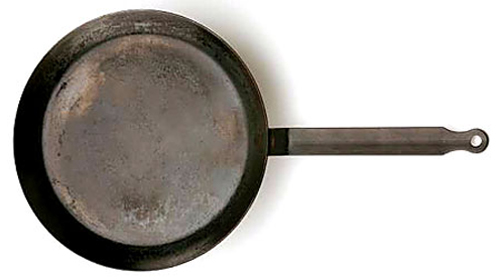From the L.A. Times

Value is a relative concept. Just ask the folks at Lehman Brothers. But when it comes to ingredients and kitchen tools that beckon to the enthusiastic home cook, it's important to the bottom line -- in this case, a great meal -- to take a look at what's really worth your hard-earned cash -- and what isn't.
We scrutinized our kitchens and the merchandise. Our thumbs-up, thumbs-down verdicts on a couple of dozen popular or hyped cooking items follow. No apologies – we're opinionated. Some gadgets and goodies are grossly overvalued, others just don't get their due. We considered cost, efficacy and practicality – as well as the happiness factor. Because for a true chocoholic, a 3.5-ounce bar of Michel Cluizel Noir de Cacao 72% cacao really is worth $6.

 For me, shopping isn't fun if I don't get a bargain. My grandmother
taught me well, "Never pay retail. If you want to be a good shopper,
you have to pay less than other people and still get as good." In our
neighborhood, Gelson's is the quality supermarket, carrying a full line of antibiotic-free, naturally raised meats. Which is great, except that they're pricey. The trick is to buy the meat when its been reduced, when a rib steak that was originally priced at $18.99/lb, is discounted to $7.99/lb. Any meat that's been reduced is still fresh, but it needs to be cooked that day
or frozen.
For me, shopping isn't fun if I don't get a bargain. My grandmother
taught me well, "Never pay retail. If you want to be a good shopper,
you have to pay less than other people and still get as good." In our
neighborhood, Gelson's is the quality supermarket, carrying a full line of antibiotic-free, naturally raised meats. Which is great, except that they're pricey. The trick is to buy the meat when its been reduced, when a rib steak that was originally priced at $18.99/lb, is discounted to $7.99/lb. Any meat that's been reduced is still fresh, but it needs to be cooked that day
or frozen. I woke up like I do any other morning, except for a nagging dream that came to me in my sleep and wouldn’t disappear until I did something about it.
I woke up like I do any other morning, except for a nagging dream that came to me in my sleep and wouldn’t disappear until I did something about it. I can’t remember a time when I didn’t have fresh garlic in my kitchen ready to smash, mince, chop or slice to use for culinary enjoyment. I’ve got cookbooks devoted to garlic and file folders bulging with recipes that include several bold, pungent cloves of the stinking rose.
I can’t remember a time when I didn’t have fresh garlic in my kitchen ready to smash, mince, chop or slice to use for culinary enjoyment. I’ve got cookbooks devoted to garlic and file folders bulging with recipes that include several bold, pungent cloves of the stinking rose. Hey, I’m not the one who shouted it out…they did, but I did consider the concept once before. You see, I have this group of tremendous and passionate foodie friends; they inhabit my supper club and like me, live their lives, loving and adoring food. They are the ones who said it, proclaiming raucously this particular Lobster Bisque was better than sex. Before I knew it, the terms orgasmic and seductive were thrown out there. I unexpectedly felt exposed at the dinner table. Had I really created something better than sex? I guess that depends upon the state of your sex life but I will say this, this bisque is incredibly sexy.
Hey, I’m not the one who shouted it out…they did, but I did consider the concept once before. You see, I have this group of tremendous and passionate foodie friends; they inhabit my supper club and like me, live their lives, loving and adoring food. They are the ones who said it, proclaiming raucously this particular Lobster Bisque was better than sex. Before I knew it, the terms orgasmic and seductive were thrown out there. I unexpectedly felt exposed at the dinner table. Had I really created something better than sex? I guess that depends upon the state of your sex life but I will say this, this bisque is incredibly sexy.